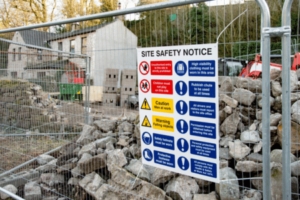The construction industry comprises the most dangerous jobs by the metric of workplace deaths alone. The Occupational Safety and Health Administration (OSHA) oversees workplace safety. It establishes protocols and standards to protect workers, and in 2020 alone, it reported 4,764 workplace deaths, 976 of which occurred in construction occupations. The following article will examine OSHA construction requirements, the most common causes of injury, employee training, and the consequences of safety violations.
Table of Contents
Introduction to OSHA Standards for the Construction Industry
Following the adoption of the Occupational Safety and Health Act of 1970, workplace injuries decreased from 10.9 incidents to 2.8 incidents per 100 workers, and thanks to the Safety and Health Regulations for Construction, also referred to as 29 CFR 1926, the majority of construction-related dangers can be identified and corrected.
The Importance of OSHA Standards in Construction
Following the adoption of the Occupational Safety and Health Act of 1970, workplace injuries decreased from 10.9 incidents to 2.8 incidents per 100 workers, and thanks to the Safety and Health Regulations for Construction, also referred to as 29 CFR 1926, the majority of construction-related dangers can be identified and corrected.
There are four specific areas, deemed the “Fatal Four” by OSHA, that are responsible for around 60% of construction site deaths:
- Falls
- Being struck by an object
- Electrocution
- Getting caught in or between objects
Injuries and deaths caused by these factors are nearly universally the results of OSHA standard violations. If workplaces were to properly institute the safety measures outlined by OSHA, nearly 600 workers’ lives would be saved annually.
The Role of OSHA in Ensuring Construction Safety
OSHA is responsible for ensuring workplace safety in the US. Regarding construction, OSHA accomplishes that goal through the following means:
- Establishing safe practices
- Conducting inspections
- Performing preventive maintenance
- Providing education and training
- Assessing Personal Protective Equipment (PPE)
- Encouraging the engineering of safer equipment and processes
- Creating illness and injury programs for employees
Unpacking OSHA Construction Requirements
Each part of the construction industry’s OSHA standards focuses on possible threats to worker safety.
General Safety Requirements in Construction
Subpart C of the safety requirements contains information on the prevention and response to hazards. The responsibility for ensuring workplace compliance falls on the employer, though they may designate competent individuals to perform inspections of job sites, equipment, and materials.
Specific OSHA Construction Requirements for Different Roles
OSHA provides guidance for dangers in electrical contracting, highway construction, residential construction, and the sealant, waterproofing, and restoration industry. OSHA training requirements for construction state that workers must be able to identify workplace hazards, avoid workplace hazards, and properly use PPE.
OSHA Outreach training courses offer workers an avenue for receiving the education they need regarding these requirements. There are two training levels:
- 10-hour training – For all construction workers
- 30-hour training – For workers in supervisory or safety roles
After completing one of these courses, the worker will receive a card, either the OSHA 10 or OSHA 30, signifying the completion of their course.
Common OSHA Construction Violations and How to Avoid Them
OSHA standards violations can carry heavy fines and even jail time for employers. The following violations are not only the most common but also the ones that cause the most injuries and deaths:
Top OSHA Construction Violations
Violation 1: Lack of Fall Protection
For fall protection, OSHA requires harnesses, guardrails, and lifelines. Without them, workers can experience severe fall injuries or death.
Violation 2: Inadequate Scaffolding Safety
Scaffolding must have provisions to prevent falls, appropriate guardrail height, crossbracing, mid-rails, footings, platforms, guying ties, and braces, or it can become a falling hazard or potentially collapse.
Violation 3: Insufficient Hazard Communication
Employees need safety data sheets, labeling, and training regarding hazardous chemicals; without such information, employees can become exposed.
Violation 4: Inadequate Respiratory Protection
OSHA’s silica, asbestos, asphalt, and carbon monoxide regulations require respiratory PPE to prevent employees from inhaling materials that can lead to illness, injury, or death.
Violation 5: Improper Lockout/Tagout Procedures
Control of hazardous energies (electrical, pneumatic, chemical, thermal, hydraulic, mechanical) requires lockout/tagout practices, which safely disable machinery to avoid the release of said energies. Without these LOTO procedures in place, workers can sustain life-threatening injuries from still-active machines.
Violation 6: Unsafe Ladder Use in Construction
Secured ladders must be the right type and height. Standing on the top rung, carrying objects while climbing, and leaning away from the ladder can all result in serious injury or death.
Violation 7: Inadequate Eye and Face Protection
Common violations include not wearing helmets, masks, goggles, steel-toed boots, and other common PPE, and without these items, workers can be blinded, deafened, receive head injuries, or even experience dismemberment.
Violation 8: Improper Use of Powered Industrial Trucks
More commonly known as forklifts, these machines can cause injuries and fatalities due to lifting oversized loads, tipping over, running over or impaling employees, or falling off due to improper riding. OSHA standards require riders to be over 18 and receive proper forklift training.
Violation 9: Lack of Proper Training for Machinery Use
Workers must receive training from qualified individuals, or they’ll be using unsafe operating procedures, which damage tools and can lead to serious injuries.
Violation 10: Insufficient Fall Protection Training
Workers must understand proper techniques for preventing falls from rooftops, ladders, or scaffolds, lest they be oblivious to the dangers of leaning off ladders, forgetting to inspect scaffolds, or disconnecting from harnesses on roofs.
Strategies to Prevent OSHA Construction Violations
To maintain compliance, construction employers should do the following:
- Stay up to date with OSHA regulations
- Perform regular workplace safety inspections
- Investigate employee safety complaints
- Keep records of illnesses, injuries, OSHA inspections, and citations
- Identify violations and correct them
- Provide employees and new hires with proper safety training
The Impact of Adhering to OSHA Standards for the Construction Industry
OSHA construction requirements are not suggestions; they are regulations that must be followed for a construction employer to remain in business and keep its workers safe.
Benefits of Compliance with OSHA Standards
Workers’ deaths, injuries, and illnesses can be drastically prevented and reduced by ensuring compliance with these standards.
Consequences of Non-Compliance with OSHA Standards
Workers’ deaths, injuries, and illnesses can be drastically prevented and reduced by ensuring compliance with these standards
Elevating Safety in Construction Through OSHA Standards
By adhering to OSHA’s safety standards, construction injuries and fatalities can be reduced or eliminated, especially those caused by the Fatal Four. You can do your part by familiarizing yourself with OSHA’s standards and — if you’re an employer — taking action to become compliant with these standards. If you need further assistance, AOTC provides training and education for workers in the construction industry.


